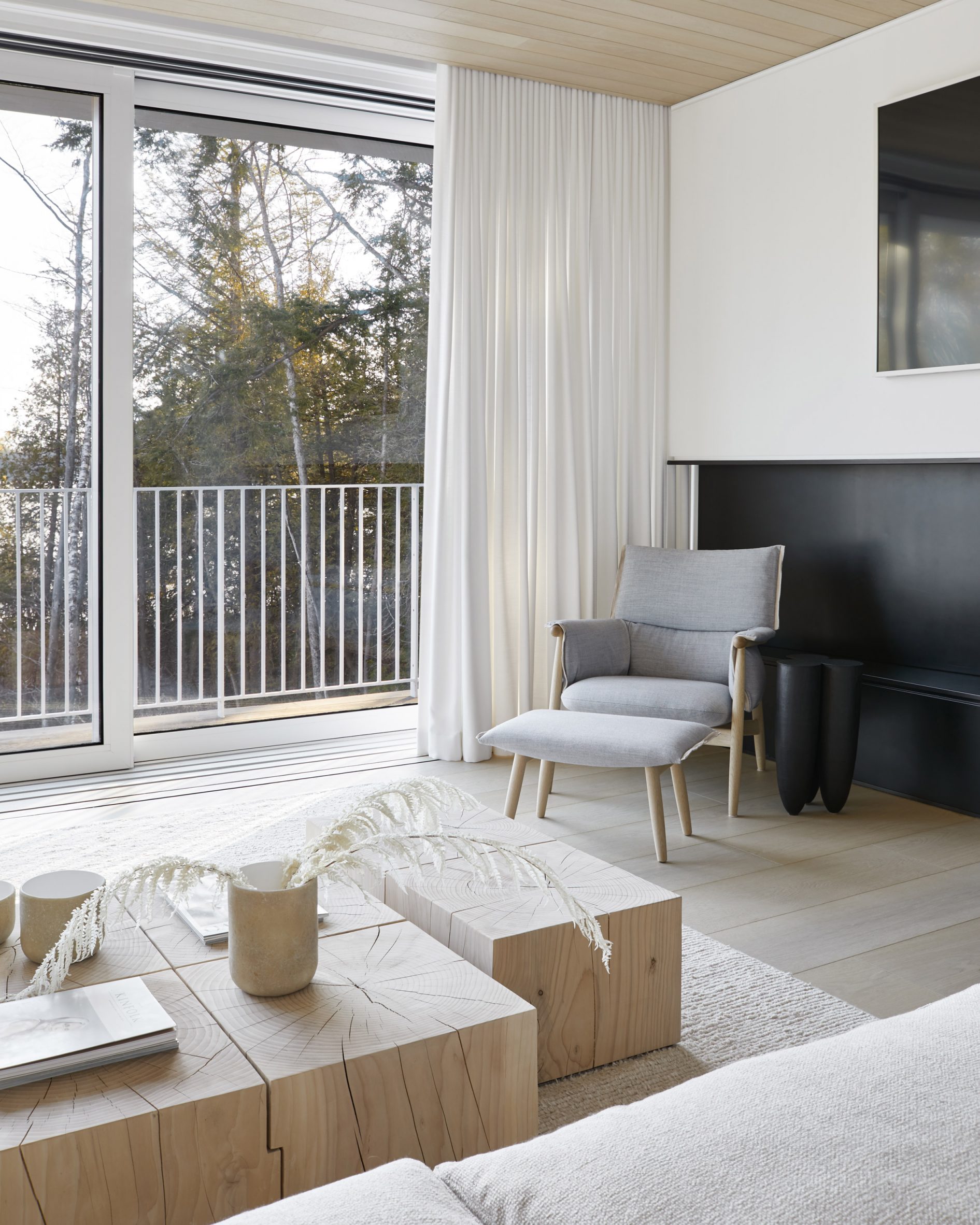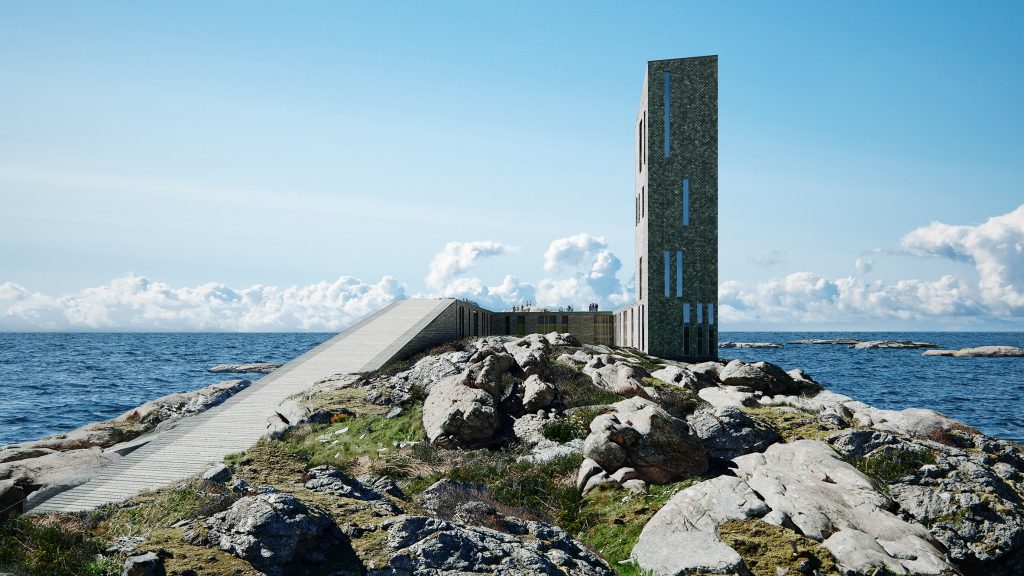Saunders Architecture designs "ribbon-like" Lily Pad house in Ontario


Canadian architect Todd Saunders has shaped this white house next to Lake Rousseau to create a continuous route through its interior and exterior spaces.
Saunders Architecture designed the Lily Pad residence for a Toronto couple that wanted a rural retreat in the Muskoka region north of the city.
 The Lily Pad house wraps around and over on itself
The Lily Pad house wraps around and over on itself
The area is dotted with rivers and lakes, and has a particular architectural vernacular that includes cottages and boathouses with ample porches, decks and terraces.
"[The clients] found a 16-acre site on the edge of Lake Rosseau... and began thinking about building something for themselves that would integrate with the setting but also be decidedly modern," said the firm, which is based in Bergen, Norway.
 Saunders Architecture designed the house as a modernist take on the vernacular of Muskoka
Saunders Architecture designed the house as a modernist take on the vernacular of Muskoka
On a trip to Fogo Island – an artists' community off the coast of Newfoundland – the clients visited some of the studios designed by Saunders, and chose to commission him to design their house.
The project encompassed a five-bedroom residence, a separate guesthouse, and a boathouse on the lake. Matt Ryan served as the local architect of record.
 Large glazed panels on the upper floor overlook Lake Rosseau
Large glazed panels on the upper floor overlook Lake Rosseau
"Both the architect and his clients wanted to maximise the sense of connection with the landscape, while creating a home with a dynamic and original character of its own," the Saunders Architecture team said.
The main house comprises two rectangular bars arranged in a cross formation, one on top of the other.
 The glass doors open up to turn the living area into a giant porch
The glass doors open up to turn the living area into a giant porch
Two ends are joined together to form a square on one side, resulting in a continuous "ribbon-like" form thanks to an angled section that bridges the level change.
Entered via a covered carport, the ground level has four bedrooms and ensuite bathrooms. A staircase next to the door leads directly upstairs, thanks to its placement at the intersection of the main volumes.
 Studio Author designed the neutral interiors
Studio Author designed the neutral interiors
An alternative route to the first floor is via the media room, where stairs and bleacher-style seating follow the inclined portion of the building.
The house can also be accessed from a grand exterior staircase that rises from the lake to the glazed upper facade that overlooks it.
 Colours and materials were chosen to complement the surroundings
Colours and materials were chosen to complement the surroundings
Sliding panels open to a formal dining area and more casual lounge seating on either side.
"When the glass slides back, this space becomes – in effect – an enticing open porch, or 'Muskoka room'," the studio said.
 The interiors have a minimal yet cosy atmosphere
The interiors have a minimal yet cosy atmosphere
Fireplaces divide the open-plan living space from the kitchen on one side and the main bedroom suite on the other.
"Floating beyond the main body of the house, the master bedroom levitates in a dramatic manner, becoming a lookout station facing the lake view to the front," said the firm.
[ 
Read:
Saunders Architecture unveils five house designs for Canadian wilderness development
Continuing the axis from the external stairs, more glass doors lead out to the roof.
An outdoor route traces the circulation path inside, rising up over the media room to reach the top terrace, which is also accessible by elevator.
 A grand external staircase provides direct access to the first floor
A grand external staircase provides direct access to the first floor
"The roof terrace becomes the final destination within an ambitious 'promenade architecturale' – somewhat reminiscent of the journey seen at Le Corbusier's iconic Villa Savoye – that takes you up from the ground plane towards the floating first floor and, finally, to the roof," said Saunders Architecture.
The guest house has a similar modernist aesthetic as the main residence, while the boathouse is clad in timber to reference the local boat-building tradition.
 Arranged like a cross, the home's upper and lower volumes are joined by an angled portion
Arranged like a cross, the home's upper and lower volumes are joined by an angled portion
Interiors by Ontario-based Studio Author draw from the surroundings, with blond wood, white cabinetry, marbled stone and pale furniture used to create a neutral yet cosy atmosphere.
"The details and palette are reflective of the hues and patterns of the water, sand and stone native to Muskoka," the firm said.
 The angled portion houses a media room with tiered seating that follows the incline
The angled portion houses a media room with tiered seating that follows the incline
Originally from Newfoundland, Todd Saunders founded his studio in 1998 and has worked extensively across Norway, Canada and beyond.
He designed his own house in Bergen with blackened timber cladding, and recently completed a white house overlooking the city in collaboration with Swedish design practice Claesson Koivisto Rune.
The photography is courtesy of Saunders Architecture.
The post Saunders Architecture designs "ribbon-like" Lily Pad house in Ontario appeared first on Dezeen.
#all #architecture #residential #houses #canada #saundersarchitecture #ontario #canadianhouses #whitehouses



 Saunders Architecture has designed a hotel on the coast of Fedje
Saunders Architecture has designed a hotel on the coast of Fedje The hotel will feature a shingle-clad tower
The hotel will feature a shingle-clad tower A ramp will lead up to a rooftop walkway
A ramp will lead up to a rooftop walkway Visitors will be able to walk under the building on one side
Visitors will be able to walk under the building on one side
 The bedrooms will have uninterrupted views of the ocean
The bedrooms will have uninterrupted views of the ocean